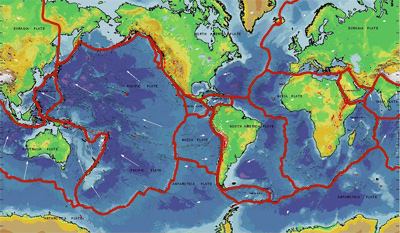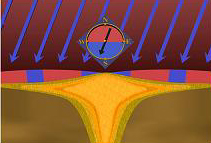This image shows the topography, or shape, of the Earth's surface, on land and below the oceans. Mountain ranges, subduction trenches, tectonic plates, and mid-ocean ridges are all visible in the image.
Click on image for full size
Image from: U.S. Geological Survey
Surface Features of the Earth
Look at this picture of the surface of the Earth! Can you find these features?
(Click on the image to see labeled examples of these features.)
These features prove that, unlike other planets, the surface layer of the Earth moves very slowly like inner tubes in a swimming pool.
Compare this active surface with that of Venus, Mars, or Europa.
You might also be interested in:

Mountains are built through a general process called "deformation" of the crust of the Earth. Deformation is a fancy word which could also mean "folding". An example of this kind of folding comes from
...more
Many forces change the surface of the Earth over time. The largest force that changes our planet's surface is movement of Earth's outer layer in a process called plate tectonics. As shown in this picture,
...more
Scientists have found that ancient Mars was similar to Earth! Magnetic field lines flow from the north pole to the south, but sometimes they switch. When scientists look at the lines, they can see how
...more
Ash is formed as a volcano erupts when rocks made by the volcano blow apart into millions of tiny pieces. The rocks are still very hot, because they just formed from lava. If the hot rocks come into contact
...more
Cinder cones are simple volcanoes which have a cone shape and are not very big. Compare the size of this volcano to the strato-volcano in this image. They are usually made of piles of lava, not ash. During
...more
Lava can move in two ways, wide flat lava flows, or through channels which squeeze the lava into a small area. The fastest lava flows move at about 6 mi/hr, an easy jog, but they average between 2/3 and
...more
Plates at our planet’s surface move because heat in the Earth’s core causes molten rock in the mantle layer to flow. We used to think the Earth’s plates just surfed on top of the moving mantle, but now
...more















